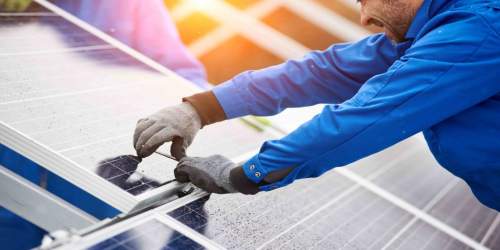Read Time : 8 Minutes
How much Space do I need for Solar Panels
An increasing number of people are investing in solar panels, at some point the question 'how many solar panels do I need?' will be asked. This is exciting for the world of renewable energy, as it means more people are contributing to green, environmentally friendly energy whilst saving money on their energy bills. It’s beneficial to the planet, but also to our bank accounts, as the energy produced is free and the payback period is relatively well within the lifespan of the system. However, it is also important to know how much solar power you need, or will generate, per square foot (sq ft) or per square meter (m2) before you install.
On this page we will investigate how much space you will need on your roof, how much generation you will get from your panels and what all this means for your pocket.
The Basics
When we talk about solar panels, we usually refer to the power produced in watts (W), kilowatts (kW) or kilowatts per hour (kWh). An example of this in context would be that the average household requires a 4-6kW system in order to produce enough electricity to cover most, it not all of the electrical requirement. A 5-14kW capacity battery is usually required if you want to cover as much of your electrical usage as possible.
Now, a 3kw system will need to be around 226 sq. ft or 21 m2. This may sound quite large, but when we put it into a different measurement, it only comes out at 15ftx15ft or 4.57x4.57m. This will easily fit on most rooftops in the UK.
The output of your solar panel system will depend on the size of the system or kW capacity that you have installed, as well as the panel efficiency, the direction in which the panels face, the pitch of the roof, any shading and finally, if the suns actually shinging! If you want to get the most from your solar panels, they should be facing south and at an angle of 32 degrees with no shade.
COMPARE PRICES FROM LOCAL INSTALLERS
Compare prices from local companies fast & free
Enter your postcode to compare quotes from leading professionals. We promise to keep your information Safe & Secure. Privacy Policy
So, how much electricity per Square Foot or Square Meter?
The amount of electricity (in kilowatts) that you can expect to generate per square foot of solar panels in the UK can vary based on several factors, including the location's solar irradiance, panel efficiency, tilt, shading, and weather conditions. However, I'll provide you with a general estimation based on typical conditions.
Solar Irradiance: The UK receives less sunlight compared to sunnier regions, which affects the solar panel's output. On average, you can expect around 850 to 1,100 kilowatt-hours (kWh) of solar energy per square meter (approximately 10.764 square feet) annually.
Panel Efficiency: Solar panel efficiency determines how well the panel converts sunlight into electricity. The average efficiency of commercially available solar panels is around 15% to 20%.
Given these values, we can calculate the estimated electricity generation per square foot of solar panels in the UK:
Estimated electricity generation (kWh/square foot/year) = (Solar irradiance per square meter) x (Panel efficiency) x (Conversion factor)
Conversion factor: To convert square meters to square feet, we use the conversion factor of 1 square meter ≈ 10.764 square feet.
Let's assume an average solar irradiance of 975 kWh/m²/year and a panel efficiency of 17%:
Estimated electricity generation (kWh/square foot/year) ≈ (975 kWh/m²/year) x (0.17) x (1 m² ≈ 10.764 ft²)
≈ 166.275 kWh/square foot/year
Keep in mind that this is a rough estimation, and actual results may vary depending on the factors mentioned earlier. Additionally, solar panel technology is continually improving, so newer and more efficient panels might yield higher electricity production in the future.
How much does this all cost?
Lets assume that you're buying a 4kW system for £7000. You're paying £1,750 per kW installed.
Keep in mind that this cost is an upfront investment and does not take into account factors like maintenance, installation, and operational costs, which can affect the overall cost of electricity generated by the system over its lifetime.
A 4kW system will never actually output 4kW, in fact the installer will likely install an inverter with capacity to handle around 3.8kW.
Let's assume an average of 5 hours of full sun per day with optimal conditions. In 2022 UK average was 4.9 sunlight hours.
Calculate the daily energy generation: Multiply the system capacity (3.5kW) by the average daily sunlight hours (5 hours) to get the daily energy generation in kilowatt-hours (kWh).
Daily Energy Generation = 3.5 kW × 5 hours = 17.5 kWh
Calculate the annual energy generation: Multiply the daily energy generation (17.5 kWh) by the number of days in a year (365) to get the total annual energy generation in kilowatt-hours (kWh).
Annual Energy Generation = 17.5 kWh/day × 365 days = 6387.5 kWh
So, in optimum conditions, a 3.5kW solar panel system could generate approximately 6387.5 kilowatt-hours of electricity in a year. Please remember that this is an estimation, and actual performance will vary due to weather conditions, system efficiency, and other factors. Given that the average cost per unit of electricity in the UK is £0.34, the potential savings, if you used every kWh produced by your panels yourself and didn't send any back to the grid, is approx. £2171 per year.
Sounds great but don't get too excited. These are the workings for a system in perfect, optimal conditions, for the maximum possible output. We've set this out purely as a guideline to start from.
Realistically, a 4kW system in the UK will provide an average of 3000-3400 kWh/s per year due to all the conditions mentioned above (solar irradiation, orientation, weather, pitch, efficiency, shading etc). This works out at approx. 8 to 9.5 kWh/s Per Day or 0.3 to 0.4 kWh/s Per Hour.
As a standard 4kW solar PV system requires about 28 m2 of roof space, this works out to approx. 121 kWh/s PA per m2 of installed roof area.
On the plus side, the average three bed property in the UK with 2-3 occupants uses approx. 7.94 kWh/s per day, so a 4kW solar panel system is, with a battery, capable of providing all your electricity needs.
Solar Panel Sizes UK
Solar panels have become increasingly popular in recent times as the cost of solar PV has fallen, and the cost of energy has soared. Solar panels can save you money but when it comes to purchasing a solar array it’s important to understand sizes for optimal energy generation. If your solar array is not sized correctly you can end up spending more than you should or with a solar system that is too small to meet your needs. Whilst the installer is on your roof, if there's space, it's often worth adding the extra panels. Adding a few extra panels can be very cost effective in the long run. It is important to consider the different solar panel sizes to avoid wasted resources and lost savings.
What Does Solar Panel Size Mean?
Solar panel size refers to not only their physical dimensions and weight but also to their size in terms of wattage (power output).
Let’s take a look at each aspect of a solar panel’s size.
Solar Panel Physical Dimensions
Solar panels are generally measured in millimetres (mm), centimetres (cm), or metres (m). The physical size of the solar panel is measured by taking the length, width, and height (thickness) of the individual panel including the frame. In terms of dimensions, standard domestic solar panels in the UK are 189cm (length) x 100cm (width) x 3.99cm (height) while standard commercial solar panels in the UK are 195cm x 99cm x 3.81cm.
However, there is no universal size or dimension for either domestic or commercial roofs. While there isn’t usually much flexibility when it comes to choosing solar panel dimensions it is more important to prioritise the size (power output) of the solar panels over dimensions as this will determine how much energy you generate. The physical dimensions of a solar panel do not necessarily have any bearing on its power output (size). More powerful solar panels may require larger dimensions to accommodate more solar cells.
Solar PV panel dimensions depend largely on factors such as the manufacturer and panel type. By way of example here are some solar panel dimensions in millimetres from popular manufacturers
- Canadian Solar: 1765 X 1048 X 40mm
- Tesla: 1890 x 1000 x 40mm
- Panasonic: 1722 x 1133 x 35mm
Physical dimensions need to be factored in to ensure solar panels fit snugly on your roof. The physical dimensions of your solar panels will of course affect how many you can fit on your roof. Once you know how many solar panels will make up your solar system you will need to calculate how much roof space is required. Standard building regulations require solar panel installations to not extend 200mm beyond the edge of the roof or wall; to not be larger than 9m2, to be less than 4m in height, and to be more than 5m away from garden boundaries.
Solar Panel Weight
Solar panel weight is extremely important as it is essential that your roof can bear the weight of your solar installation. If you don’t consider this, you risk damaging your roof which can be both dangerous and extremely expensive. Fortunately, a complete survey is part of your installer’s solar quote process. Your roof’s health and structural status will be assessed during the survey.
The standard solar panel weight in the UK is 18 – 21kg for residential settings and 22 – 30kg for commercial settings. The weights of the frames and mounting equipment are included in these weights. In most cases, rooftops have a rafter load of 140kg per square metre. To put this in perspective, solar panels usually weigh approximately 20kg per square metre.
This means that installing panels will increase the dead load by about 15% per square metre. Though the weight of your roof shouldn’t cause you too much worry, all roof structures should be assessed by a professional solar panel installer to make sure your roof is robust enough for the solar panel system.
Solar Panel Size – Power Output
How many solar panels do I need? Wattage measures how much electricity a solar panel generates per hour. The higher a solar panel's wattage, the more energy it will produce. The more panels you install the more energy will be generated. How many panels your system will be comprised of will be determined by how much energy you require.
For example, a regular 2kW solar panel system which would work for 1-3 people will need between 5 and 8 solar panels (for 350Wpanels). For the system to generate the electricity required you would need to receive about 4 hours of sunlight a day and the positioning and efficiency of the panels would need to be optimal.
The average domestic solar system will usually provide between 3kW and 5kW of power in total and is made up of about 6 to 12 panels altogether. The reason for this is that systems are generally sized to meet UK households' average energy consumption, which according to Ofgem is around 2900kwh a year.
The big question is - how much electricity can a solar panel array produce? In most cases, a 3kW or 4kW will be able to generate enough electricity to provide about 50-70% of the average UK household’s demand while a 2kW will be able to supply around 25-50% of the average UK household demand. A 4kW system will, typically, generate approx. 4500kWh/s of electricity per year. Click the link for more info.
The most common solar panel systems are around 3-5kW. For households of 5 people or properties with high energy usage, maybe a heat pump or an EV, a 6kW+ solar panel system with a battery may well be the best fit.
Based on products from top solar panel manufacturers such as SunPower, Canadian Solar, Trina Solar, and Jinko Solar, the standard domestic solar panel size in the UK is 250W – 400W and the standard commercial solar panel size in the UK is 400W – 600W.
Some properties will be limited by the physical number of panels that can fit on their roof. For example, there may not be enough space on their south-facing elevations. If you don't have much space on your roof, then it's often a good idea to look at panels with higher wattage output.
Efficiency is also important and must be factored into the system installed. The average silicon-based solar panel has an energy efficiency of around 15-22%. Higher efficiency often equates to a higher quality solar product and will mean your system can produce more energy throughout the year.
There are three main types of solar panels, monocrystalline, polycrystalline, and thin-film solar panels. Your solar panel installer will advise you on the best type for your home but monocrystaline panels are the most common and efficient.
Monocrystalline Solar Panels
Made from single-crystal silicon, a monocrystalline solar panel is the most reliable type of solar panel. They are a popular choice for domestic installations and are a uniform black colour with rounded edges. A monocrystalline residential solar panel tends to come in two sizes: 60-cell and 72-cell. The 60-cell panels are about 65 by 39 inches and have a power output of around 280-320 watts, and the 72-cell panels are about 77 by 39 inches and have more power output of around 340-400 watts. Canadian Solar panels weighed in at the heaviest at up to 50 pounds.
Polycrystalline Solar Panels
Made from melted multiple small silicon crystals these solar panels have a distinctive blue colour. They are slightly less efficient than monocrystalline PV cells but are also cheaper. Polycrystalline panels come in different sizes, from small-weight panel options for portable use to large-weight commercial solar panels. Typical sizes for commercial installations include 60 cell panels and 72 cell panels. The 60-cell panels are 65 x 39 inches with an electrical output of 280-320 watts and the 72-cell panels are 77 x 39 inches with an electrical output of around 340-400 watts. These solar panels are also good for residential solar installations.
Thin-Film Solar Panels
These solar cells are created by depositing a thin layer of photovoltaic material onto a substrate such as glass, plastic, or metal. They aren’t as efficient as crystalline cells but are a sleek weight, flexible, and can be made in various sizes and shapes. There are two main types of TF solar panels: amorphous silicon and cadmium telluride.
Considering wattage, weight, and dimensions is essential to designing the system that meets the criteria for your ideal system. All these factors are considered during the solar array survey process.
Advantages of Solar Energy
- It’s a renewable energy source. This means it will not run out (at least, not for another 5 billion years or so). It is also a clean source of energy, so does not cause pollution after initial manufacture.
- It reduces your electricity bills. The electricity generated by solar panels is technically free as you do not pay for it, reducing the cost of your monthly or annual energy bill. Plus, you can sell the surplus energy back to the grid through the Smart Export Guarantee (SEG).
- It has diverse applications. It can be used to generate electricity, but also for heating. It can be used in areas that don’t have access to the National Grid or for exp, to distill water in regions with limited clean water supplies.
- Maintenance costs are low. The panels don’t require much maintenance aside from a quick wash a couple of times a year. They last around 50 years, and the warranties tend to cover around half of that time.
- Constant development. One of the great things about solar technology is the constant research and development going on to make them more efficient, lighter on your roof and more aesthetically pleasing.
- When installed specifically for purpose, solar panel systems with batteries can operate in a power cut.
- They can potentially remove your relience on energy companies, or at least protect you from the year-on-year cost increase of electricity.
Are There Risks?
Solar panels actually tend to be quite low risk because they don’t have any moving parts, aside from a small inverter. This tends to be the part that may need replacing at some point. Plus, they have great lifespans and warranties.
One of the important things to remember is that you should always use an MCS accredited installer, as not doing so could risk poor installation and also void your warranty. MCS accredited installers know what they are doing and will ensure it is installed to industry standards, as well as providing you with a guarantee. Without MCS installation, you will also not be eligible for the Smart Export Guarantee, should you want it any point.
It is also worth contacting your insurance provider and checking if they require the install to be MCS ceritfied.
As a general rule, you should get at least three quotes before you make a decision on which company you wish to go with.
Want to Know More?
Have you found yourself interested in solar panels? If you want to know more then click the links on the left or visit our online directory of REH approved installation companies. Alternatively, simply give us a ring using the number at the top of this page and have a chat.
Find a local installer
Welcome to the biggest directory of UK renewable energy companies





 How Much do Solar Panel Systems Cost in 2024?
How Much do Solar Panel Systems Cost in 2024?







